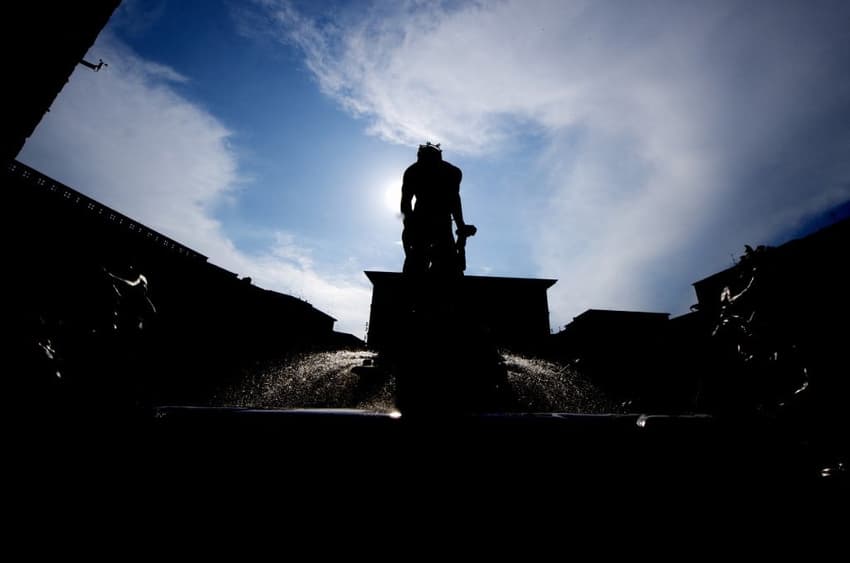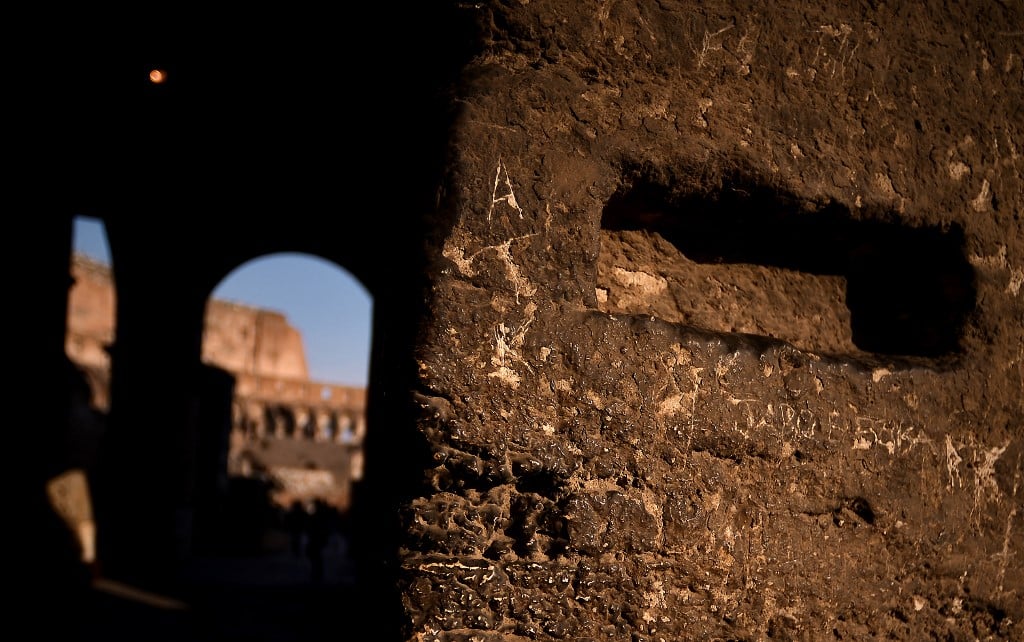Why do so many tourists damage Italy’s historic monuments?

After a German man became the latest to damage a statue by climbing on it for photos on Monday, Italy's culture minister said fines and prison sentences must be increased to stop unruly visitors from defacing Italy’s cultural heritage. But is that the answer?
A 22-year-old German tourist caused €5,000 worth of damage to the 16th-century statue of Neptune in Florence's Piazza della Signoria after climbing on it to have photos taken, the city mayor’s office said in a statement on Monday.
In the latest of a long series of incidents involving tourists climbing on and damaging historic monuments in Italy, the man was seen on security camera posing on the fountain as two friends took photos in the early hours of Monday morning.
He damaged part of the horse’s hoof with his foot while climbing on the statue, and broke off a piece of red marble from Neptune's chariot, the mayor’s office said.
Questo turista ha pensato bene di salire sul Nettuno per un selfie. Per fortuna nessun danno, il sistema di allarme ha funzionato. Grazie alle telecamere del Comune è stato individuato e pagherà una multa salata. Contro il vandalismo sui beni culturali non ci sono giustificazioni pic.twitter.com/QVvBNYaygI
— Dario Nardella (@DarioNardella) September 4, 2023
City police tracked the man down and he now faces criminal charges of damage to a cultural monument, which carries a maximum fine of up to €15,000 and even a prison sentence of up to five years.
READ ALSO: Why Italy needs a national plan for sustainable tourism - before it’s too late
The incident came just weeks after the Vasari Corridor in Florence was sprayed with graffiti, while several tourists reportedly faced criminal charges and steep fines after carving their initials into Rome's Colosseum.
In July, Rome's tourism councillor called for access to the Trevi fountain to be restricted after a spate of incidents of tourists climbing on or swimming in the historic monument.
Every summer in Italy, there are countless such reports of tourists damaging, defacing, and even stealing pieces of cultural landmarks across the country - though it’s unclear how many of those caught are prosecuted.

Every summer brings reports of tourists swimming in and climbing on Rome's Trevi Fountain and other historic monuments. Now, local politicans say it's time to crack down. (Photo by Filippo MONTEFORTE / AFP)
Culture Minister Gennaro Sangiuliano said the incident on Monday showed why the government plans to introduce tougher penalties for damage to cultural monuments, saying higher fines and prison sentences would be the “right deterrent”.
The government in April approved an increase to the maximum fines for defacing cultural property to €40,000, while anyone damaging or destroying monuments could be fined up to €60,000.
Potential prison sentences would also increase to a maximum of seven years under the plans, which are yet to be made into law.
READ ALSO: What punishments do tourists face if they damage Italian monuments?
But, while these tougher penalties could be applied to tourists who deface monuments, they're not the main target.
The tougher punishments were approved following a spate of protests by Italian climate activists, who have repeatedly thrown paint, soup, or flour at, or glued themselves to, notable landmarks or artworks in Italy in a bid to focus political and public attention on impending climate disaster.
Some legal experts say tougher punishments are not necessarily going to stop anyone from damaging monuments.
Italian law is already “very clear, and provides for severe penalties for anyone who damages or defaces monuments,” lawyer Giulia Andreozzi, based in Cagliari, told Italian media.
READ ALSO: 'Selfies and ignorance': Italy's Colosseum director slams badly-behaved tourists
Andreozzi points out many areas lack security and surveillance systems and that, in many cases, “identifying those responsible is very difficult… many are foreign tourists who leave Italian soil after a few days.”
“Harsher penalties, introducing new crimes, announcing crackdowns by threatening tougher penalties serves no purpose other than propaganda: it would be enough to apply the rules that already exist.”

Names are seen carved on a wall inside Rome's Colosseum. Photo by Filippo MONTEFORTE / AFP
Vandalism by tourists is reported far more often in Italy than in other neighbouring countries, and tourism experts believe the issue is more to do with the scale of both Italy’s cultural heritage and its tourism industry.
“Italy is peculiar in the wealth of tourism features the country has, and it’s unique in that people occupy these spaces in a way that doesn’t occur in many countries,” Tom Jenkins, CEO of the European Tourism Association (ETOA), told CNN in July.
In cities like Venice and Rome, people live among “fragile” cultural treasures, he explained.
“I think what we’re watching is a byproduct of the sheer volume of visitors, and the appalling behaviour of a fraction of the total number,” he said.
In July, the Colosseum archaeological park's director blamed "ignorance" and self-centredness among visitors for a string of incidents of vandalism at the site.
“The will of the tourist-vandal is to leave their own mark, because we are by now a society oriented towards ourselves," said director Alfonsina Russo.
“See the 25,000 tourists who visit the Colosseum every day who are primarily interested in taking selfies,” she said.
Comments (1)
See Also
A 22-year-old German tourist caused €5,000 worth of damage to the 16th-century statue of Neptune in Florence's Piazza della Signoria after climbing on it to have photos taken, the city mayor’s office said in a statement on Monday.
In the latest of a long series of incidents involving tourists climbing on and damaging historic monuments in Italy, the man was seen on security camera posing on the fountain as two friends took photos in the early hours of Monday morning.
He damaged part of the horse’s hoof with his foot while climbing on the statue, and broke off a piece of red marble from Neptune's chariot, the mayor’s office said.
Questo turista ha pensato bene di salire sul Nettuno per un selfie. Per fortuna nessun danno, il sistema di allarme ha funzionato. Grazie alle telecamere del Comune è stato individuato e pagherà una multa salata. Contro il vandalismo sui beni culturali non ci sono giustificazioni pic.twitter.com/QVvBNYaygI
— Dario Nardella (@DarioNardella) September 4, 2023
City police tracked the man down and he now faces criminal charges of damage to a cultural monument, which carries a maximum fine of up to €15,000 and even a prison sentence of up to five years.
READ ALSO: Why Italy needs a national plan for sustainable tourism - before it’s too late
The incident came just weeks after the Vasari Corridor in Florence was sprayed with graffiti, while several tourists reportedly faced criminal charges and steep fines after carving their initials into Rome's Colosseum.
In July, Rome's tourism councillor called for access to the Trevi fountain to be restricted after a spate of incidents of tourists climbing on or swimming in the historic monument.
Every summer in Italy, there are countless such reports of tourists damaging, defacing, and even stealing pieces of cultural landmarks across the country - though it’s unclear how many of those caught are prosecuted.

Culture Minister Gennaro Sangiuliano said the incident on Monday showed why the government plans to introduce tougher penalties for damage to cultural monuments, saying higher fines and prison sentences would be the “right deterrent”.
The government in April approved an increase to the maximum fines for defacing cultural property to €40,000, while anyone damaging or destroying monuments could be fined up to €60,000.
Potential prison sentences would also increase to a maximum of seven years under the plans, which are yet to be made into law.
READ ALSO: What punishments do tourists face if they damage Italian monuments?
But, while these tougher penalties could be applied to tourists who deface monuments, they're not the main target.
The tougher punishments were approved following a spate of protests by Italian climate activists, who have repeatedly thrown paint, soup, or flour at, or glued themselves to, notable landmarks or artworks in Italy in a bid to focus political and public attention on impending climate disaster.
Some legal experts say tougher punishments are not necessarily going to stop anyone from damaging monuments.
Italian law is already “very clear, and provides for severe penalties for anyone who damages or defaces monuments,” lawyer Giulia Andreozzi, based in Cagliari, told Italian media.
READ ALSO: 'Selfies and ignorance': Italy's Colosseum director slams badly-behaved tourists
Andreozzi points out many areas lack security and surveillance systems and that, in many cases, “identifying those responsible is very difficult… many are foreign tourists who leave Italian soil after a few days.”
“Harsher penalties, introducing new crimes, announcing crackdowns by threatening tougher penalties serves no purpose other than propaganda: it would be enough to apply the rules that already exist.”

Vandalism by tourists is reported far more often in Italy than in other neighbouring countries, and tourism experts believe the issue is more to do with the scale of both Italy’s cultural heritage and its tourism industry.
“Italy is peculiar in the wealth of tourism features the country has, and it’s unique in that people occupy these spaces in a way that doesn’t occur in many countries,” Tom Jenkins, CEO of the European Tourism Association (ETOA), told CNN in July.
In cities like Venice and Rome, people live among “fragile” cultural treasures, he explained.
“I think what we’re watching is a byproduct of the sheer volume of visitors, and the appalling behaviour of a fraction of the total number,” he said.
In July, the Colosseum archaeological park's director blamed "ignorance" and self-centredness among visitors for a string of incidents of vandalism at the site.
“The will of the tourist-vandal is to leave their own mark, because we are by now a society oriented towards ourselves," said director Alfonsina Russo.
“See the 25,000 tourists who visit the Colosseum every day who are primarily interested in taking selfies,” she said.
Join the conversation in our comments section below. Share your own views and experience and if you have a question or suggestion for our journalists then email us at [email protected].
Please keep comments civil, constructive and on topic – and make sure to read our terms of use before getting involved.
Please log in here to leave a comment.